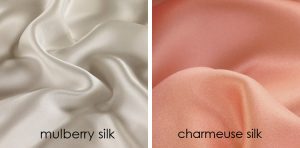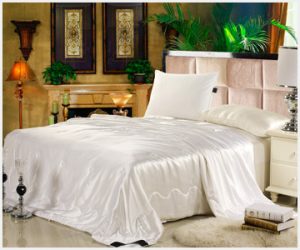Silk is an animal protein fibre produced by certain insects, like worms and spiders, to build their cocoons and webs. It is one of the popular fabrics for apparel because of its unique properties. Silk is most luxurious fabric, the most comfortable fabric, the most absorbent of fabrics (equal to wool), the best fabric for drape, the best fabric for color, capable of the greatest lustre, having the finest “hand” etc. These are some of the factors which make the fabric more popular. The fabric is cool in summer and warm in winter
Maintaining Silk
Unwashed silk chiffon may shrink up to 8% due to a relaxation of the fiber macrostructure, so silk should either be washed prior to garment construction, or dry cleaned. Dry cleaning may still shrink the chiffon up to 4%. Occasionally, this shrinkage can be reversed by a gentle steaming with a press cloth. There is almost no gradual shrinkage nor shrinkage due to molecular-level deformation.
Uses of Silk
Silk’s absorbency makes it comfortable to wear in warm weather and while active. Its low conductivity keeps warm air close to the skin during cold weather. It is often used for clothing such as shirts, ties, blouses, formal dresses, high fashion clothes, lining, lingerie, pajamas, robes, dress suits, sun dresses and Eastern folk costumes. For practical use, silk is excellent as clothing that protects from many biting insects that would ordinarily pierce clothing, such as mosquitoes and horseflies. Silk’s attractive lustre and drape makes it suitable for many furnishing applications. It is used for upholstery, wall coverings, window treatments (if blended with another fiber), rugs, bedding and wall hangings. While on the decline now, due to artificial fibers, silk has had many industrial and commercial uses, such as in parachutes, bicycle tires, comforter filling and artillery gunpowder bags
- Home Decor, Furnishings
Silk fabric may be used to make silk sheets, silk pillow cases, table cloths, throw covers and other home items.
Silk fabrics can also be used for decorations and occasionally used as a high-end wall covering.
I looked it up because I knew that while silk has had many industrial and non-apparel uses in the past, it seems like most of those have been replaced by cheaper and more durable synthetics. They still make silk comforters in China, although they’re expensive. And once upon a time, silk underwear was de rigeur for serious winter campers and hikers, but now people use the cheaper and easier-to-wash polypropylene version.

